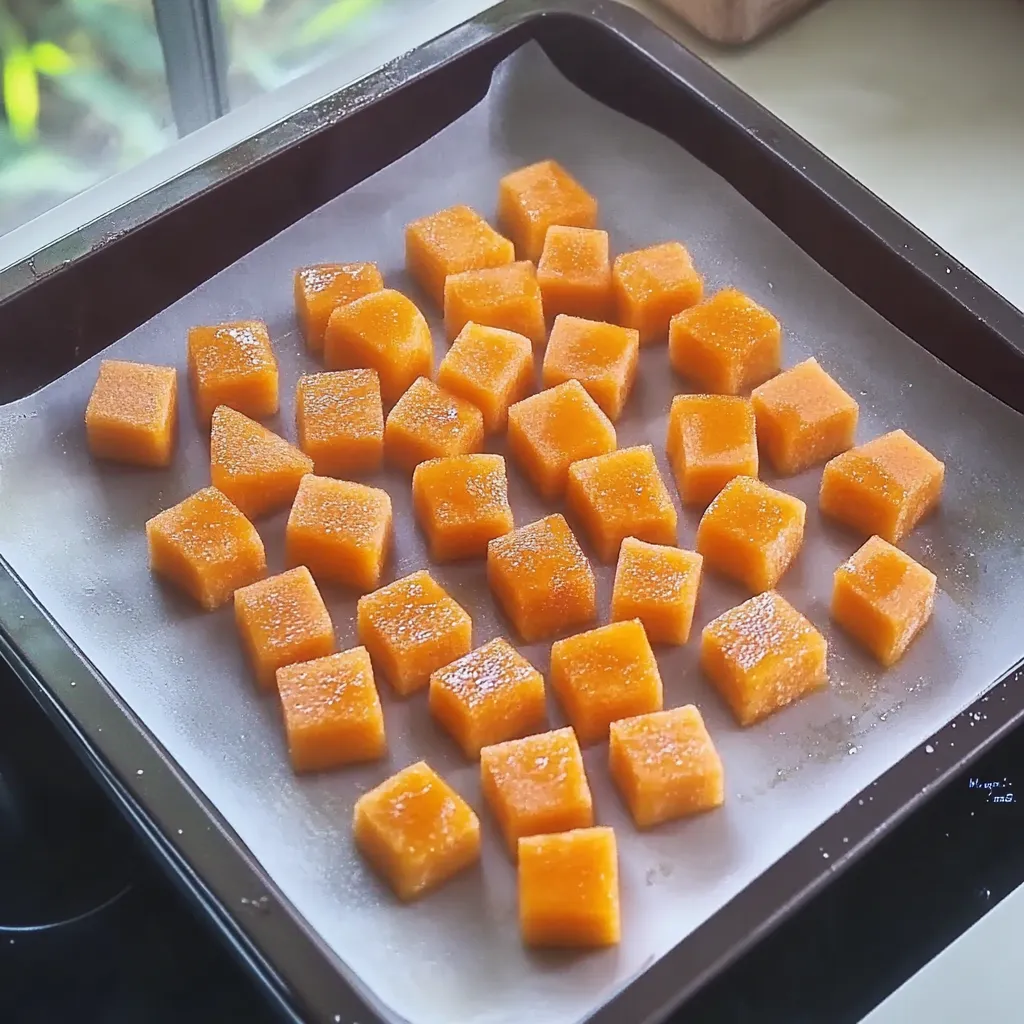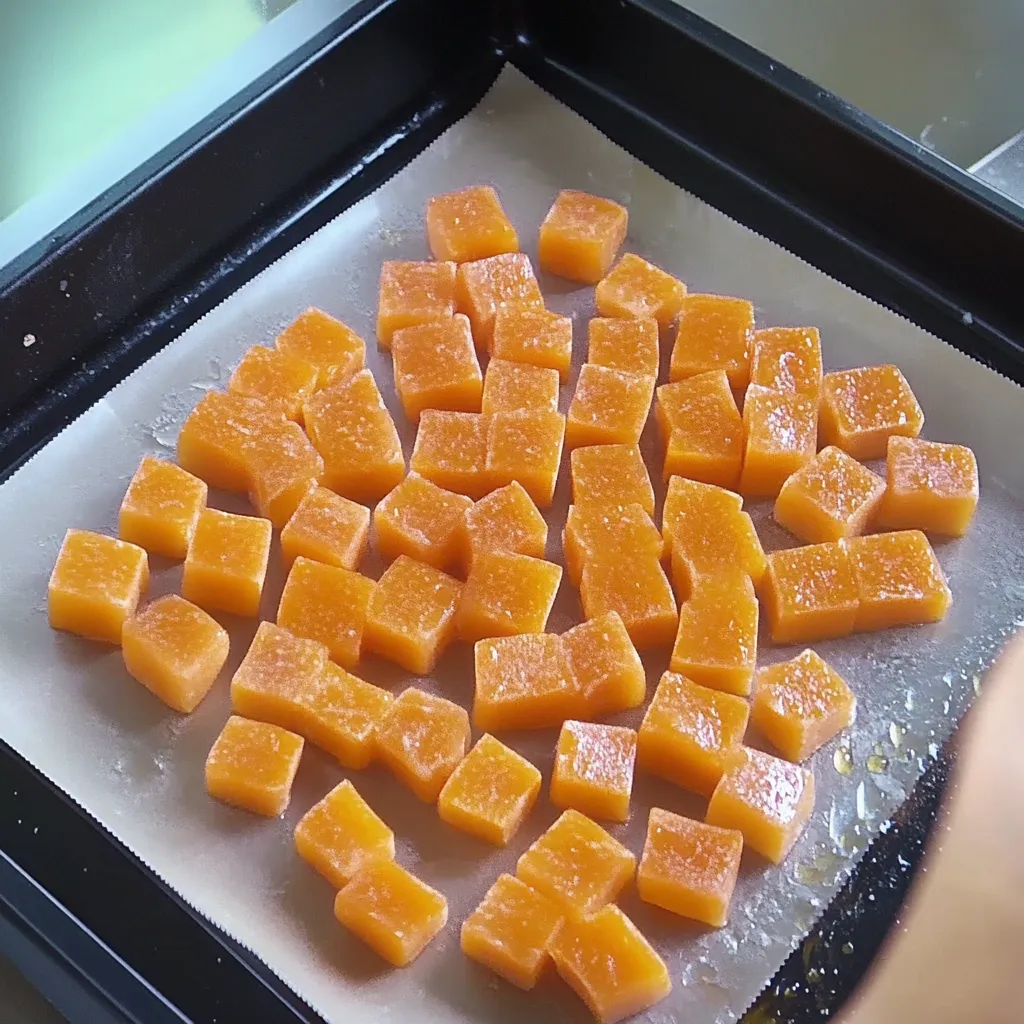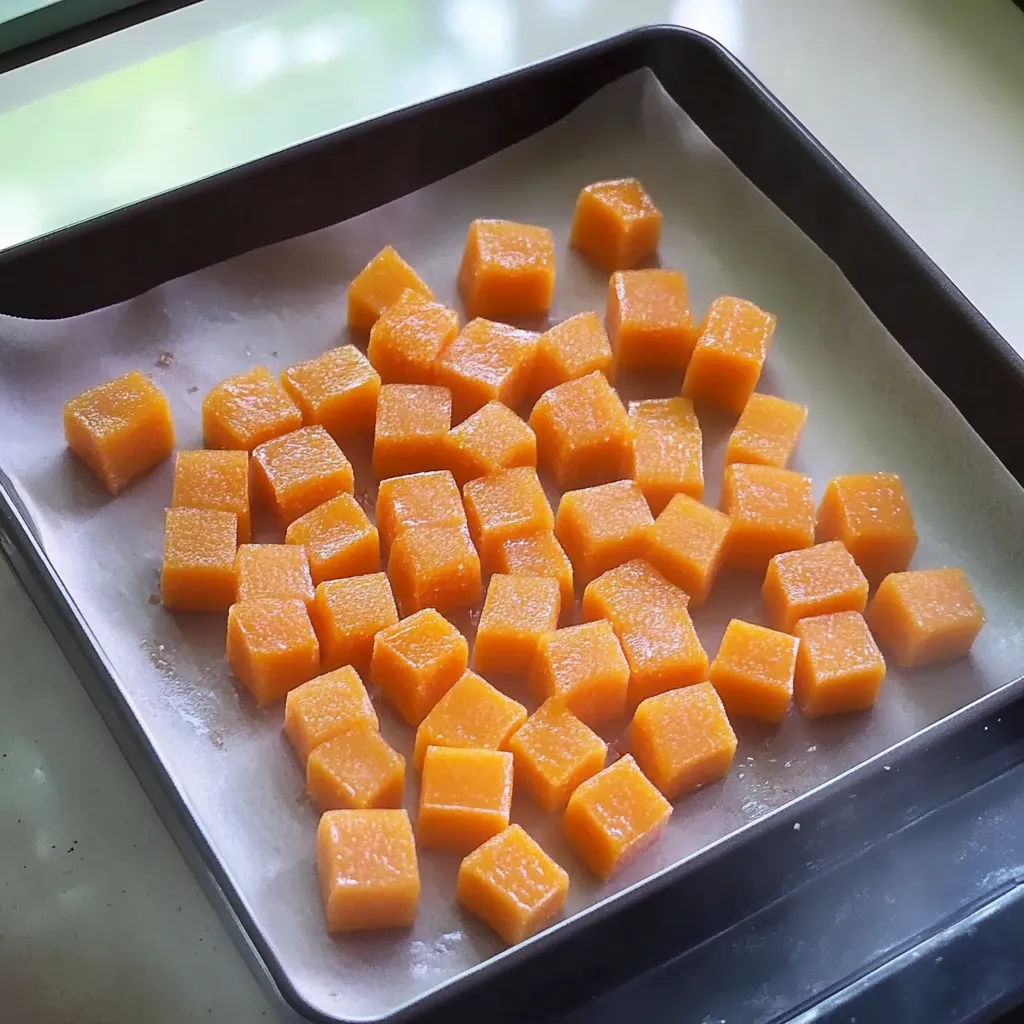 Pin it
Pin it
This homemade Chinese mango candy brings the tropical flavors of mango and passion fruit together in a delightfully chewy treat that outshines any store-bought version. The combination of fruity tanginess and sweet syrup creates the perfect balance that makes these candies irresistibly addictive.
I first made these candies during a summer when my local market had an abundance of ripe mangoes and passion fruits. The vibrant color and intense tropical flavor instantly transported me back to the street markets I visited in China, where vendors would slice these treats from large slabs and wrap them in colorful paper.
Ingredients
- Passion fruits (10 medium): Provides the perfect tangy counterpoint to the sweet mango and creates depth of flavor
- Mango flesh (80g): Choose ripe mangoes with deep orange flesh for the best color and sweetness
- White sugar (70g): Enhances the natural sweetness of the fruits while helping with preservation
- Mizuame or maltose syrup (200g): Creates that signature chewy texture traditional Asian candies are known for
- Cornstarch (35g): Acts as the thickening agent that gives the candy its firm yet pliable consistency
- Water (40g): Needed to create the cornstarch slurry for proper thickening
- Butter (35g): Adds richness and a smooth mouthfeel to the finished candy
Step-by-Step Instructions
- Prepare the Fruit Juices and Pulp:
- Cut passion fruits in half and scoop out the pulp with a spoon. Place the pulp in a sieve and press gently to extract about 100120 ml of juice while removing all seeds. Take care not to crush the seeds as this will affect the final texture of your candy. Next prepare the mango by cutting 80g of fresh flesh into small pieces and blending until completely smooth. The smoother your puree the better the final candy texture will be.
- Make the Gummy Mixture:
- Combine the passion fruit juice mango puree sugar and mizuame in a medium saucepan over low heat. Stir continuously until the syrup completely dissolves into the fruit mixture. This creates your flavor base. In a separate bowl mix cornstarch with water until you have a smooth slurry with absolutely no lumps. As your fruit mixture begins to simmer gradually pour in the cornstarch slurry while stirring vigorously to prevent any lumps from forming. The mixture will thicken almost instantly.
- Cook the Gummy Mixture:
- Reduce heat to the lowest possible setting and add the butter to your thickened mixture. Stir constantly until the butter melts completely and the mixture becomes glossy and smooth. Continue stirring for another 1520 minutes allowing the mixture to develop the perfect consistency. You know it's ready when it coats the back of a spoon and flows slowly when drizzled from a height. This extended cooking time also helps develop flavor and ensures the candy will set properly.
- Set the Candies:
- Line a baking tray with parchment paper and pour the thickened mixture onto it. Use a spatula to spread it evenly across the tray. Cover with another sheet of parchment paper and gently press down to create an even surface about 1 cm thick. Allow the mixture to cool completely at room temperature which usually takes 12 hours. You'll know it's ready when the candy feels firm yet slightly elastic to the touch.
- Cut and Serve:
- Once fully set carefully peel away the parchment paper and transfer the candy slab to a cutting board. Use a sharp knife to cut into small squares or rectangles approximately 23 cm each. For an extra special touch you can roll the cut pieces in granulated sugar which adds a pleasant textural contrast and prevents them from sticking together when stored.
 Pin it
Pin it
The passion fruit is my favorite ingredient in this recipe. I discovered its magic when a Chinese friend shared her grandmother's recipe with me. She explained that while mango provides the recognizable flavor, it's the subtle tartness of passion fruit that makes these candies truly special, adding complexity that keeps you coming back for more.
Storage Tips
For best results, store these delicious mango candies in an airtight container with parchment paper between layers to prevent sticking. They will keep at room temperature for about a week, but for longer storage up to two weeks, refrigeration is recommended. The texture may become slightly firmer when chilled, so you might want to let them come to room temperature before enjoying. Avoid storing in very humid environments as the candies can absorb moisture and become too soft.
Ingredient Substitutions
If you cannot find fresh passion fruit, you can substitute with 100ml of store-bought passion fruit puree or juice, though the flavor won't be quite as vibrant. For the mizuame or maltose syrup, light corn syrup can work in a pinch, though the texture will be slightly different. Vegans can replace the butter with coconut oil for a dairy-free version that still maintains a rich mouthfeel. You can also experiment with different tropical fruits like pineapple or papaya in place of mango for interesting flavor variations.
Cultural Context
These fruity candies are inspired by traditional Chinese fruit leather known as "bing tang," which has been made for centuries using seasonal fruits preserved with sugar. Historically, these treats were created as a way to enjoy fruit flavors year-round, especially during winter months when fresh fruit wasn't available. The addition of mizuame, a Japanese rice syrup, reflects how culinary techniques often crossed borders throughout Asia. In modern China, mango candies like these are particularly popular during Lunar New Year celebrations, symbolizing sweetness and prosperity for the coming year.
 Pin it
Pin it
Enjoy making these homemade candies, and prepare to wow your friends and family with this tropical treat!
Frequently Asked Questions
- → Can I substitute mizuame or maltose syrup with something else?
Yes, you can substitute mizuame or maltose with corn syrup or honey, though the texture may vary slightly. Corn syrup will create a similar result, while honey will add its own distinct flavor to your candies.
- → How long will these mango candies stay fresh?
When stored in an airtight container at room temperature, these candies will stay fresh for about 1-2 weeks. For longer storage, refrigerate them for up to a month, though they may become slightly firmer.
- → Can I use frozen mango instead of fresh?
Yes, frozen mango can work well in this candy. Just thaw it completely and drain any excess liquid before blending into a puree to maintain the proper consistency in your final product.
- → Why is my candy too soft or not setting properly?
If your candy isn't setting properly, you likely didn't cook the mixture long enough or the cornstarch wasn't fully activated. Make sure to cook the mixture for the full 15-20 minutes until it thickens enough to coat the back of a spoon and flow slowly.
- → Can I add other flavors to this candy?
Absolutely! You can experiment with adding vanilla extract, citrus zest, or even a splash of coconut extract for different tropical variations. Add these at the end of the cooking process to preserve their flavors.
- → Do I need to use both mango and passion fruit?
While the combination creates the signature flavor, you can make the candy with just mango if preferred. Replace the passion fruit juice with an equal amount of mango puree or other fruit juice for a different but still delicious result.
